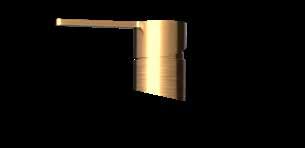
5 minute read
Tapware: form & function
Design trends are veering towards earthy colour palettes and natural finishes, whilst also experimenting with metallics and patterned tapware. Shown here is the Loft tall basin mixer in brushed copper from Waterware’s tapware range.
TAPWARE:
Form & Function Consumers are spoilt for choice with tapware styles and options but there is more than meets the eye when it comes to the design and production process, as Waterware explains.

When combined, three key components—the main body, cartridge and finish—deliver an appealing bathroom, kitchen or laundry tap for consumers.
The body The body will typically be manufactured using one of two base materials: stainless steel or brass. Though equally popular, each has unique characteristics. One key distinction is that brass tapware is much easier to form into different shapes and designs and can be finished in a wide variety of surfaces and colours. Stainless steel tapware is a little harder to form, so can be a more expensive option. However, stainless steel alloy has rust resistant properties and can be used in outdoor environments, depending on the grade.
The finish Both brass and stainless steel tapware can have different colours and finishes applied to the base material, which is done using an electroplating process or PVD coating.
Looking after taps Despite the hard-working nature of a household tap, its care and maintenance can sometimes be overlooked. Consumers quite often ask for advice on the best way to keep a tap clean to ensure it maintains its looks and performance over time.
Waterware recommend regular use of standard cleaning products, such as a spray and wipe together with a soft cloth. It is not advisable to use any abrasive cleaners that could tarnish the tapware and void the warranty. Electroplating Electroplating is the process of plating one metal onto another by hydrolysis—most commonly used for decorative purposes, or to prevent corrosion of a metal. This form of additive manufacturing is referred to as an electro-deposition process. Both an anode and a cathode (the metal part to be coated) are immersed in an electrolytic bath composed of a solution of salts, including the metal to be plated. A direct current (DC) of electricity passed through the solution effects the transfer of metal ions onto the cathodic surface, plating the metal onto the item.
Many materials are suitable for electroplating, including brass, nickel, gold and silver. The process gives the product additional strength and corrosion resistance, enhancing its durability. PVD coating PVD coating, also known as thin-film coating, is a process in which a solid material is vaporised in a vacuum and deposited onto a part’s surface. These coatings are not simply metal layers, however. Compound materials are deposited atom by atom, forming a thin, bonded metal or metalceramic surface layer that greatly improves the appearance, durability, and/or function of the part or product.
Both processes offer a high-quality application, so the decision as to which is best to coat a tap comes down to the

Lever Handle
This exploded view shows the ceramic disc cartridge within a tap.
Hot/Cold Indicator
Collar Trim
Brass Retaining Nut
Cartridge

Locating Lugs
Mixer Body
Perlator
colour or finish chosen, and how it can best be applied. Chrome and matte black finishes are still very common options in the marketplace, but soft-brushed golds, bronzes and coppers are also becoming increasingly popular.
The cartridge The third key component of the tap is the cartridge. Ceramic disc cartridges are found inside most taps and contain two discs with holes through them. One disc is fixed in place whilst the other moves with the tap handle, so water can flow through the tap when both discs are aligned. When they are not aligned, water flow will stop. Ceramic disc cartridges are very durable and generally manufactured to last a lifetime.
It is not usually the ceramic tap cartridges that fail but the inlet or outlet seals falling apart or the build-up of sediment within them that creates leakages. In some cases, it also depends on the hardness of the water and the quality of the tap itself.
A less expensive tap, even with ceramic discs, is going to wear down over time. However, the ease and low cost of replacing a cartridge means any cartridge-related issue can be a relatively easy fix.
About the author: Waterware, over many years, have developed a range of market-leading tapware and are always looking for opportunities to innovate through style and finish. Waterware are proud to offer ‘10 years of guaranteed satisfaction’ on all their tapware, including their many coloured tapware ranges. To discuss your next tapware project, feel free to call Waterware on 0800 WATERWARE or view their range at www.waterware.co.nz
SOLUTIONS • BATHROOM • HEATING & COOLING • PLUMBING
YOU CAN’T MANAGE WHAT YOU DON’T MEASURE.
Managing water consumption in a multi-user environment such as a residential apartment block is critical to ensure water charges are accurately allocated to tenants. Waterware’s HYDROLINK wireless water meter system does just this – effective measurement of water consumption. The system enables the remote collection and transmission of data recorded by the meter via a wireless network. The solution provides for a range of transmitting and receiving hardware options from simple ‘walk by’ to fully automated GPRS transmission solutions.
The solution offers a range of benefits including:
• Significant time and cost saving over more traditional
RADIATOR SOLUTIONSmanual recording systems • Leak detection • Fraud /attempted tamper alarm • Error free data reading and transcription • Direct export data in excel format • Easy to use software The HYDROLINK system uses the M-BUS wireless transmission protocol and will piggy back 3rd party power and or gas reading equipment on the same system. With over 12,000 water meters sold in the past 3 years and currently 335 active systems operating across various sites, the HYDROLINK system provides a reliable and proven solution. For further information, please feel free to call us on 0800 WATERWARE or email us at info@waterware.co.nz and we would be happy to discuss your requirements.










